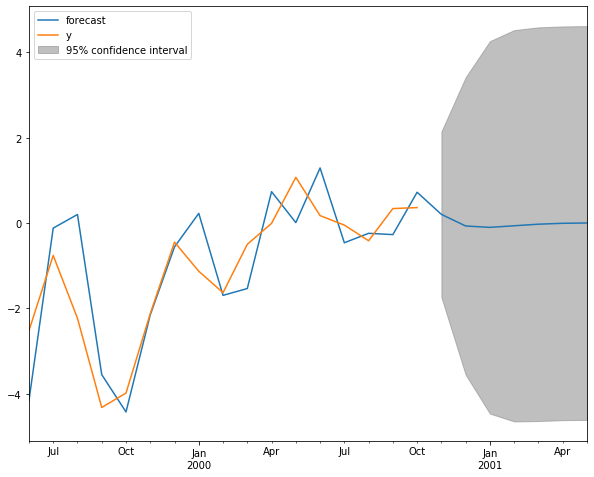Autoregressive Moving Average (ARMA): Artificial data¶
[1]:
%matplotlib inline
[2]:
import numpy as np
import statsmodels.api as sm
import pandas as pd
from statsmodels.tsa.arima_process import arma_generate_sample
np.random.seed(12345)
Generate some data from an ARMA process:
[3]:
arparams = np.array([.75, -.25])
maparams = np.array([.65, .35])
The conventions of the arma_generate function require that we specify a 1 for the zero-lag of the AR and MA parameters and that the AR parameters be negated.
[4]:
arparams = np.r_[1, -arparams]
maparams = np.r_[1, maparams]
nobs = 250
y = arma_generate_sample(arparams, maparams, nobs)
Now, optionally, we can add some dates information. For this example, we’ll use a pandas time series.
[5]:
dates = sm.tsa.datetools.dates_from_range('1980m1', length=nobs)
y = pd.Series(y, index=dates)
arma_mod = sm.tsa.ARMA(y, order=(2,2))
arma_res = arma_mod.fit(trend='nc', disp=-1)
/home/travis/build/statsmodels/statsmodels/statsmodels/tsa/base/tsa_model.py:162: ValueWarning: No frequency information was provided, so inferred frequency M will be used.
% freq, ValueWarning)
[6]:
print(arma_res.summary())
ARMA Model Results
==============================================================================
Dep. Variable: y No. Observations: 250
Model: ARMA(2, 2) Log Likelihood -353.445
Method: css-mle S.D. of innovations 0.990
Date: Tue, 17 Dec 2019 AIC 716.891
Time: 23:40:00 BIC 734.498
Sample: 01-31-1980 HQIC 723.977
- 10-31-2000
==============================================================================
coef std err z P>|z| [0.025 0.975]
------------------------------------------------------------------------------
ar.L1.y 0.7904 0.134 5.878 0.000 0.527 1.054
ar.L2.y -0.2314 0.113 -2.044 0.041 -0.453 -0.009
ma.L1.y 0.7007 0.127 5.525 0.000 0.452 0.949
ma.L2.y 0.4061 0.095 4.291 0.000 0.221 0.592
Roots
=============================================================================
Real Imaginary Modulus Frequency
-----------------------------------------------------------------------------
AR.1 1.7079 -1.1851j 2.0788 -0.0965
AR.2 1.7079 +1.1851j 2.0788 0.0965
MA.1 -0.8628 -1.3108j 1.5693 -0.3427
MA.2 -0.8628 +1.3108j 1.5693 0.3427
-----------------------------------------------------------------------------
[7]:
y.tail()
[7]:
2000-06-30 0.173211
2000-07-31 -0.048325
2000-08-31 -0.415804
2000-09-30 0.338725
2000-10-31 0.360838
dtype: float64
[8]:
import matplotlib.pyplot as plt
fig, ax = plt.subplots(figsize=(10,8))
fig = arma_res.plot_predict(start='1999-06-30', end='2001-05-31', ax=ax)
legend = ax.legend(loc='upper left')
